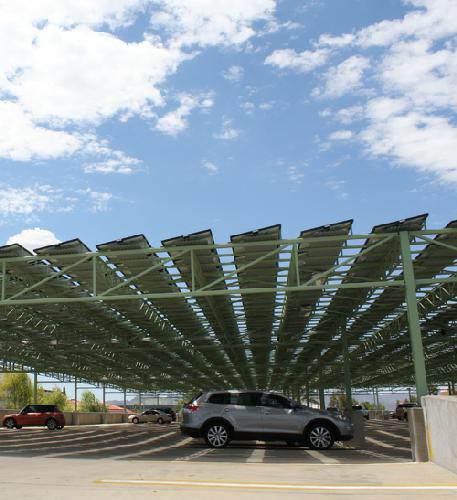The way this campus uses energy could change drastically in the next few years.
Multiple University of Arizona offices collaborated with Tucson Electric Power to create a plan to shift the campus to 100% purchased renewable energy.
According to Trevor Ledbetter, the director of the UA Office of Sustainability, the plan ensures 100% of the campus’ purchased electricity for its grid plan will come from renewable sources, but not total electricity on campus.
“The university does produce … approximately 40% of its own electricity using traditional fossil fuel resources,” Ledbetter said. “So 60% of our total electricity use will come from renewable energy resources, but 100% of our grid purchase resources will come from renewable resources.”
RELATED: UA joins coalition researching climate change policy
Ledbetter said that the reason the plan still states 100% renewable energy is because it will completely address one category of emissions, Scope 2 Emissions, at the UA.
“Scope 2 Emissions are indirect emissions which result from your purchases of utilities from the grid,” Ledbetter said. “For us, that’s inclusive of steam, electricity etc. For us, we only purchase electricity from the grid. So, through the deal with TEP, we’re offsetting 100% of the carbon emissions in that space by purchasing only renewable energy from TEP.”
Joseph Barrios, the supervisor of media relations and regulatory communications at TEP, said that in the deal with the UA, they will supply solar and wind power to UA through its own facilities, which will completely drive down Scope 2 Emissions on campus.
According to Barrios, the deal will be facilitated through the UA paying a fixed “green energy charge,” for the sustainable energy they will provide.
Barrios said that some of the energy they will be delivering to the campus will come from two new sustainable projects.
“TEP will dedicate some of the power from two new renewable energy projects to serve the UA: a wind farm in New Mexico and a solar plus storage system southeast of Tucson,” Barrios said. “TEP already provides electric service to the UA using both traditional and renewable resources.”
Barrios said the wind farm is called the Oso Grande Wind Project and constructions will start later this year. He also said the solar power system is called the Wilmot Energy Center and that its construction will start in January. They both are expected to be completed in 2020.
Chris Kopach, the assistant vice president of facilities management at UA, said the deal with TEP came out of a review and survey for the whole campus, which was looking to see how the UA could improve on sustainability.
According to Kopach, a company called CustomerFirst Renewables initially assisted UA in exploring a renewable energy power purchase agreement along with other contract structures. However, the UA ultimately came to an agreement with TEP to create this new, renewable energy deal.*
“The talks led to further talks, which led to, ‘Let’s see if we can partner in a collaborative fashion and come up with a renewable credits program,’” Kopach said.
Kopach said the deal quickly made sense, as TEP already had the two renewable energy facilities in the works for its overall customer base customers and plans, which then coincided perfectly with the deal.
“So, we looked at the project, we negotiated at many times, we looked at the costs, driving down costs and utilities, and this just really came together nicely over the last several months,” Kopach said.
According to Kopach, the deal was possible because of the strong leadership that surrounded it, including TEP, the university, the Office of Sustainability, the UA’s chief financial officer Lisa Rulney and President Robert C. Robbins.
Kopach said that the deal excites a lot of people who have worked hard on it.
“It was a lot of time and effort — a lot of hours put into this, and we’re are all very excited to be quite frankly one of the first universities of our size who can say we’ve eliminated 100% of our Scope 2 Emissions,” Kopach said. “That will be in basically a year and four months. That’s a major accomplishment and we’re all very excited about this project.”
RELATED: UA alumni and Students for Sustainability leaders take on jobs in the sustainability field
According to Ledbetter, there is still a part of the deal that has to be approved.
“The green energy piece of the deal has not yet been approved,” Ledbetter said. “It will go before the Arizona Corporation Commission, where it will be vetted to ensure that the agreement does not benefit the University of Arizona at the expense of other ratepayers under TEP. We’ve gone through the necessary processes with TEP to ensure that this is not the case, and both the UA and TEP expect the ACC to approve the deal in the next three to six months.”
Ledbetter said that he believes that deal is an important step to take against the growing danger of climate change.
“It is important for the UA to lead in this space, as it is critical for our society to transition to a low or zero-carbon economy in the coming decades and to do so as quickly as possible to avert the most devastating effects of climate change and global warming,” Ledbetter said. “Tucson is already the third fastest warming city in the United States, so now is the time to act and to show other institutions of higher education how relationships with local utilities can be leveraged for more impactful action.”
*This paragraph originally as follows: According to Kopach, a company called CustomerFirst Renewables offered them a traditional power purchase agreement deal, but then conversations were made with TEP to create a new kind of deal with them.
Follow Jake Toole on Twitter









